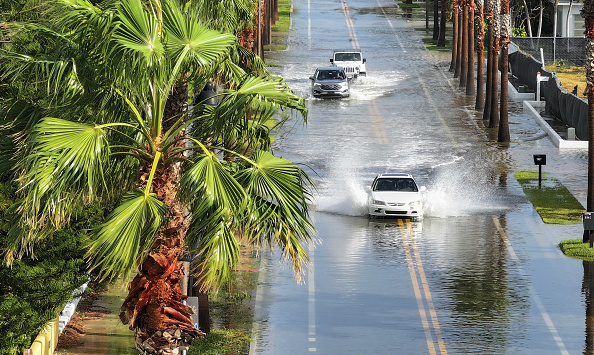The catastrophic flash floods in Texas a couple of days earlier, triggered by extremely heavy rainfall, which caused over 100 deaths and widespread destruction, have once again raised a pressing question- are flash floods directly linked to climate change? Successive research by environmental agencies corroborates this, saying climate change is a significant factor in the increased risk, frequency and intensity of floods in several parts of the world.
Research suggests human-caused climate change is driving more and more extreme weather conditions, which include extremely heavy and sometimes untimely rains, which directly contribute to flooding, especially when proper city planning is not in place.
Studies say warmer temperatures cause a more moisture-laden atmosphere, which turns into more intense rainfall with increased frequency. The recent Texas floods were found to have been made significantly worse by climate change, as atmospheric conditions favoured slow-moving thunderstorms, which caused heavy rains in the same area for hours. Warmer global temperatures have increased the atmosphere’s capacity to hold moisture, resulting in heavier and more concentrated rainfall events that can overwhelm drainage systems and waterways.
In layman’s terms, climate change leads to higher global temperatures and warmer air holds more moisture. Climate-related researches say with every one-degree Celsius rise in temperature, the atmosphere’s capacity to hold more water vapour rises by about 7%.
It can be understood from the fact that the recent very heavy rainstorms in Texas delivered about 20% more rainfall than they did in the late 1950s, a time when global temperatures were considerably lower, according to the National Climate Assessment. As climate change continues to warm the planet, extreme rainfall events in Texas are projected to become even more frequent in the coming decade, as highlighted in a 2024 report by the state’s climatologist. The worry is that it’s not just Texas, but across the US, the heaviest storms are predicted to produce more rain as the Earth continues to warm.
Such storms can trigger deadly flooding far inland, which was on full display in 2024 when Hurricane Helene caused severe flooding across Appalachia. Similarly, in 2021, flash floods caused by Hurricane Ida claimed dozens of lives in the Northeastern US. According to the National Climate Assessment, more than one-third of the estimated 230 billion dollar in inland flood damage in the US between 1988 and 2021 would not have occurred without climate change.
Storms increase the likelihood of intense and short-duration rainfall in several parts of the globe, which is becoming a major trigger for flash floods. Moreover, climate change also gives rise to sea levels and constantly rising sea levels invariably exacerbate coastal flooding, which seriously threatens human populations and physical assets-infrastructure in the coastal regions.
In fact, across the US, Europe and other parts of the globe, similar patterns are observed with coastal and inland states facing flood risks due to tropical storms, hurricanes and prolonged rainfall events. In the US, riverine floods are also a concern, especially along major waterways like the Mississippi. In many areas, deforestation, wetland loss and poorly planned development have also disrupted natural drainage systems, reducing the landscape’s ability to buffer heavy rains.
Like the United States, Europe is also grappling with more frequent and severe flooding. In 2021 and successive years, devastating floods in Germany, Belgium, Italy, the Netherlands, Luxembourg, Poland, the Czech Republic, Slovakia, Austria, Hungary and others highlighted the region’s exposure to extreme weather.
Climate change is intensifying heavy rainfall events across the continent, particularly in Central and Western Europe. Uncontrolled urban expansion, river channelization and reduced natural water retention due to agricultural and industrial development have made many European regions more prone to flooding. In mountainous areas, rapid snowmelt and glacial lake outbursts, both linked to rising temperatures, also contribute to sudden floods.
Studies have shown that climate change has increased the likelihood and intensity of heavy rainfall events in both the US and Europe. For example, in Europe, research indicates that human-caused climate change doubled the likelihood of the intense rainfall that caused recent floods in Central Europe. Similarly, in the US, climate change has been linked to more extreme rainstorms and increased flood risk.
Despite the growing risks, many communities around the country are still not planning for more intense rainstorms as they build roads, floodways, and storm infrastructure. Local governments around the country rely on historical rainfall records from concerned agencies.
Another factor that may be contributing to the severe floods, however, is human activity and land-use change. Most of the recent floods in Central Europe are river floods, which makes the links between the flooding and climate change less straightforward.
Central Europe’s devastating floods were made worse by climate change, which scientists say offers glimpses of a bleak future for the world’s fastest-warming continent. In fact, Europe is the fastest-warming continent. The last five years were on average around 2.3°C warmer than the second half of the 19th century, according to the Copernicus Climate Service.
Addressing these challenges requires a multi-pronged approach. In the short term, improving early warning systems, emergency response mechanisms and public awareness can help save lives. Upgrading drainage infrastructure, reinforcing levees and dams and integrating green infrastructure like rain gardens, permeable pavements and restored wetlands are essential for long-term flood resilience. Urban planning must prioritize flood risk zones, restrict construction in vulnerable areas and promote sustainable land use.
And at a broader scale, reducing greenhouse gas emissions remains critical to mitigating the root cause of climate-driven floods. International cooperation, climate adaptation funding and policy reforms are necessary to prepare communities for the escalating risks posed by a warming world. Without decisive action, not only the US and Europe, but the majority of countries across the globe are likely to see floods becoming an even more destructive and persistent threat in the decades ahead. Without more ambitious climate action, global warming is expected to reach around 3°C by the end of the century, which would be much more disastrous to the humanity.














